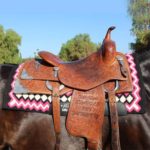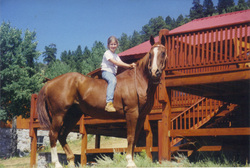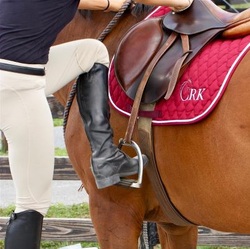Will you ride differently in English or Western tack? Is one preferable over the other? If you’re a western rider, can you still apply the advice given to (or by) a rider sitting in a jumping saddle?
I’ve had the opportunity to enjoy riding in a variety of disciplines. My first formal lessons as a kid were in Western tack, then with my first horse I spent a lot of time bareback. Next I wanted to learn to jump so I got an old Stubben and rode in that for many years. I also spent many hours in an endurance saddle out on the trails, and even tried out a few Australian saddles.
My favorite part of riding is the interaction with the horse, whether I’m jumping fences, practicing the strengthening movements of dressage, conditioning on the trail, or trying (not very successfully) to catch a cow with a rope.
The saddle you sit in will affect your riding, it may tip you forward or back, or position your leg too far forward. A saddle can help your riding or hinder it.
Also, your position will change if you’re going around a jump course vs. ambling down a trail. However, the principles of good posture, body alignment, and movement do not change. They remain the same regardless of the tack.
In this video, we are going to observe the same rider in a western then an english saddle, to see what changes and what remains constant.














32 Responses
Such an interesting video, thanks for making it! I ride English, but spend a lot of time bareback also. I’m going to now comb through looking for videos to improve my sitting trot, I don’t think I’ve heard it described as letting the jump go all the way through your back before. I definitely have a harder time sitting the bigger trots, and know my mount would appreciate it if I improved!
Hi callie!
I ride English . Mainly flat work but I still do a little jumping here and there. I absolutely love it.
This past summer I did try some western ranch horse and western pleasure with my horse to change things up. It was fun but just not for me. Riding in the western saddle I found myself sitting slightly further back and my stirrups pushed forward more. Perhaps I had them too long.
Thanks Callie. I get asked all the time, do you teach English or Western. My response generally is – I teach a balanced seat that can be used in any saddle, student picks what they’d like to ride in. Now, if going into the show ring, we’ll tweak some minor details here and there.
Your video will help people understand that it’s not the tack that determines how you ride, but what you intend to do with your riding.
You made a comment while she was doing sitting trot that she should stabilize her back a bit more to feel like she jumps with him. Could you elaborate on that a little more?
Hi Callie , I emjoy watching your videos very much , you make it easy to understand and explain well . I do have issues with sitting trot in my western saddle , I think I am tensing too much and I bounce a lot and it just doesn’t feel comfortable . Your video is excellent in showing how to sit and relax and move with the horse which I will try until it feels right . Thank you for your awesome tips !
Not to be that one… Given, I have many horses that scratch their chins with either rear hove, I don’t want any thing hanging from the tack… I know the flank cinch is not being used because horse is not working, but I’d keep that cinch up enough to keep it from hanging
How do I get over a fast cantering horse , I only walk and trot English style because riding fast on a horse scares me. How do I train myself to overcome my fear? How do I keep me horse from thrashing her head around? I had two bad experiences with other horses many years ago, and still love riding them. My horse won’t listen to half halting and likes to cut the arena corners.
Thank You!
Stefanie, I just wanted to validate your fear as I had many experiences when I was younger on “runaway” horses. I have come to understand that I tended to lean forward which makes the situation worse. Now that I am too old to take chances, I do a LOT of transitions between the halt, walk and trot to make sure the horse is listening. Often, just pacing out three to five steps between each transition. Only when I feel really secure that the horse is paying attention will I ask for a canter. I also don’t have any qualms about making sure I’m not alone when I do more than a trot until I am confident with a particular horse. As a side note, doing that first canter in a Western saddle provides the additional security if needed. Then you can go back to an English saddle.
This video is great in reinforcing balanced riding as the goal, rather than the tack driving the seat position!
Callie, thank you for this video! I always get annoyed at people who imply that riding in Western tack means that they can dispense with the shoulder-hip-ankle alignment. Not true! However, I think there are a lot of Western and English saddles out there that do put the rider in a chair seat (i.e., lower leg swings forward) because the position of the stirrup bar is too far forward and cannot be adjusted. A rider should not have to fight against their tack to maintain alignment. Every brand and model of saddle is different and a rider should ensure that the saddle works for their body conformation as well as their horse’s. The rider in the video seemed to have little problem with her alignment in the Western saddle but the English saddle put her in a chair position at the trot…that saddle looked too small for her leg length. Thanks again for these very helpful videos!
I thought the western saddle seat is further back on the horse. Would this make the horses back sore? There was quite a gap between the horn and the rider. Good video.
Kim, if the saddle is too far back it can make the horse’s back sore. The saddle placement depends no the horses girth line, we have to make sure that the saddle isn’t too far back which depends on the length of the horse’s back and the length of the saddle.
Julia Burdy, CRK Training Community Manager
I learned on an English saddle. I have ridden in a Western but didn’t really care for it–it may not have been sized for me and otherwise not adjusted well. I had an Aussie saddle for a while, and liked it as it is so much like English. I now ride in a treeless endurance-type saddle, so comfy! It has a western-type seat, but much flatter, with the center of gravity in the middle. I can post just fine in it, as I’m not comfortable with the sitting trot anyway, could never figure out how not to bounce!
I ride both western and English. I feel more comfortable in a western saddle but love English- dressage. What is the difference between the types of English saddles: close contact, all purpose, jumping and dressage? What are some of the difference in western saddles, I don’t know if I know all for them roping, barrel, trail and show?
I have ridden in both western and english saddles. I actually prefer English. However, my primary sport is long distance/endurance. I use western based endurance saddles for greater distribution of weight. I enjoyed the video and believe is helpful to viewers to see the similarity between the styles. I was taught this type of balanced ride. My question is more about particular types of saddles. I currently have 2 saddles based on the Monty Foreman Balanced Ride saddle. Both have flat seats and tend to have forward hung stirrups. One in particular real puts your legs forward so that there is no way to get the hip and heel in alignment. Are you familiar with these types of saddles, and riding style? Would you want to give your thoughts on them? ‘Thanks
Callie,
Your videos are wonder and I learn so much from each one. I was wondering if you have a slow motion video of you riding the rising trot which focuses on the leg, specifically, the heel and knee absorbing the movement. The heel going down, the calf soft but stable, the knees going forward and down. I’ve been riding for a long time and my trainer always has something to say about my leg position. She insists they are little tweaks but I feel so deflated when we constantly revisit this issue. I ride in an english saddle most of the time but I also trail ride in western saddles.
Will keep this video bookmark. I get asked a lot about riding both. It surprises people. And they seem to think they can’t ride one or the other. Great illustration. Love the split screen! Thanks! I will pass it on.
What about how the position of the hands and how the reins are held? I ride English and was taught thumbs up and reins close to withers . . . in the video, the rider holds the reins the same way when riding English and Western–thumbs sideways (facing towards one another) and reins slightly on side of neck.
I ride Western. I’ve had a heck of a time posting. From this video I can already seen I have not been lined up properly so I will try that. I have an Arabian and his gait at the trot is so bouncy I’ve had trouble getting in sync with his rhythm. It’s been so wet here, it’s been difficult to work , it’s so gloppy.
and then . . . there’s the gaited horse! Tack is somewhat different and leg/arm position very different. But, as you said, the basic alignment should be very much the same. Often you will see folks riding gaited horses in almost an armchair position – as their legs tend to go forward. That is not correct positioning. It creates a bracing against the stirrups which takes away the flexibility and softness required to move with the horse rather than against it. A proper seat would be centered and balanced as in all disciplines. This was a great video and I agree – the split screen really helped me understand! Thanks!
Thanks Callie. Another great video! I ride English in a dressage saddle now, a close contact saddle previously. I find saddle fit really affects my ride..just had my saddle adjusted and its amazing the difference it can make to ones ride. I like the way you described how to ride, absorb the movement of sitting trot..will keep this in mind. I find i brace too much with my legs…your last video about losing stirrups as well as this one, really gave me some good insights. Good stuff:)
Callie,
I have a definite preference for most English saddles but I think it has a lot to do with their twist being wider than the English. In the Western saddles I feel less contact and higher off the horse’s back and I personally feel trapped in a Western saddle; they are just too hard for me to get out of. All this, not to mention their weight–un-liftable and that annoying horn in front. I do not think the horse cares (except for the weight) and at the simple walk, trot/jog, canter, stand level, saddles seem to be rider preference. You demonstrated that well.
Callie,
I have the feeling that I am “not quite connected” as I should be. Should I be journaling with you online somewhere? I do have the bound book
I feel the same exact way about western saddles. Lol
Hi Ginny, I’m going to send you an email, because I check comments here on the blog about once a week, so would like to talk more about ways to connect, and email is better for that 🙂
I primarily ride Western, but teach beginner English. I never felt much posture change between them as I don’t jump. But I find that my (old) knees are more comfortable in the Western saddle.
I have a definite preference for an English saddle as I feel I have better contact with the horse, but my daughter’s QH has a definite preference for a Western saddle, so I am learning to adjust whenever I have to “tweak” her (the horse).
Her sister’s Arabian tends to prefer the English saddle, as do I, and I enjoy her spirit (she is younger and an Arab), though her trot is definitely more charged (is that a nice way of saying bouncier?)! I still prefer sitting to it, but I’m getting a bit older and maybe a bit lazy.
I absolutely prefer the sitting trot in an English saddle, or bareback, but honestly, don’t find a lot of difference in how it sits depending on the saddle until I go to post. I believe that previous comments mentioning stirrup placement are probably the answer to that as our saddles are not newer models (the Western ones), so holding proper and comfortable position for both rider and horse is more difficult.
My Western riding daughter was happy to see the posting trot on the Western saddle as her former instructor kept insisting that posting wasn’t the “thing” in Western riding. I understand there might be a difference in the ring, but we ride for pleasure, and until you are comfortable (and your horse is comfortable) with your sitting trot, what else can you do until you learn (to sit comfortably at the trot)?
Thanks for the video. It helped my girls a lot.
I liked the bling on your ear warmer! I might have to do that with mine.
I am learning English riding, some dressage and principles of jumping. At the same time I am figuring out how to post , etc… Over the weekend I had a lesson with a classical riding instructor who told me that my close contact saddle was high on the front, looked like a Harley sit. He made me sit back with my stirrups as long possible, legs hanging. He said that I needed to learn to ride with a closed horse, collected. It was no fun! The horse and were going to flip. I had to fight the horse to stay collected all the time while trying to ride, sitting the trot like a robot stiff. My young horse is PRE Andalusian, collects nicely, but not all the time.
Great video. My horse has a real bouncy trot and fast trot. (Ex-race horse Standardbred) I know the key is to relax, but is there any other tips or tricks? I’m trying to relax and go with the horse but he unbalances me often. Thank you. Love your videos.
Darlene have you watched our video on “How to Stop Bouncing When You Ride“?
Julia Burdy, CRK Training Community Manager
I’ve watched this over and over and now realize the stirrups on my western saddle are too far forward and can’t be changed. I’m shopping for an “in between” and leaning towards a Tucker endurance. Not quite English, not quite western. I mentioned before I have trouble posting on my quick, bouncy trotting Arab. I can’t get myself up. Thanks for these videos. I feel like they’ve all been gears towards me personally.
Such an informative video Callie – the slow motion really helps a novice like me focus on the specific independent movements of the body.
I recently got back into English, after 50+ years of western riding… and this was helpful. What brand and model number is this western roping saddle, please?
It is a TW Saddlery Texas Wade saddle!
-Julia Burdy, CRK Training Community Manager
This was so helpful at dispelling all of the confusion in the different things I have been hearing about riding position in different saddles. I especially love the summary explaining that the positional differences are generated by a purpose within a discipline and not saddle specific. THANK YOU!